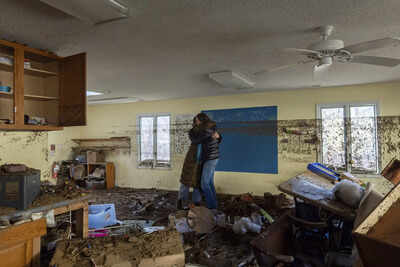ARTICLE AD BOX

Hurricane Helene swept through western North Carolina a year ago, leaving thousands of students uprooted and homes destroyed: the Appalachian region, once seen as a climate haven, found itself at the mercy of unprecedented floods, landslides, and wind.
The storm’s aftermath extended far beyond shattered structures, leaving children grappling with instability, disrupted learning, and emotional trauma. The Associated Press reports that over 2,500 students were identified as homeless directly because of Helene.For some, returning home meant threading carefully through the bare skeletons of once-familiar rooms, where exposed wires and shattered walls stood as stark reminders of everything lost.
Months later, sunlight still slipped through torn tarps where windows once framed the world outside, casting the absence of normalcy in sharp relief. In classrooms, the echoes of ruined homes lingered — panic and anxiety flaring at the slightest reminder, as children carried fragments of disaster with them into everyday life.
Families struggle to find stable housing
Across the region, stories like these were common: students attending classrooms long before their families could reclaim stability, many of them living in motels, temporary campers, or doubling up with relatives. For families in rural, low-income areas, pre-existing challenges such as food insecurity and housing affordability compounded the difficulties of recovery, said a public policy professor at the University of North Carolina at Chapel Hill, noting that many children never truly had the opportunity to heal, according to AP.
Some families faced months of uncertainty, moving from motels to donated campers, struggling against cold and damp while children maintained school attendance amid chaos. Others were forced to split across multiple temporary residences, moving between relatives, friends, and hotels, all while grappling with fear triggered by rain and storms.
Schools and infrastructure face long-term disruption
The physical destruction was staggering. Helene damaged more than 73,000 homes, leaving electricity and water out for weeks and forcing school closures across the region.
In rural Yancey County alone, students missed over two months of classes due to storm-related disruptions compounded by snow days, highlighting the broader educational toll.Displacement extended beyond individual counties. Research from UCLA’s Center for the Transformation of Schools shows that post-disaster, students frequently find themselves in unstable living arrangements such as couches, shelters, or shared homes — conditions that federal law classifies as homelessness.
Helene’s impact mirrored patterns seen in Hurricane Maria in Puerto Rico and the 2023 Maui wildfires in Hawaii, with North Carolina counties reporting dramatic spikes in students without permanent housing.
Yancey County, for instance, saw the number of homeless students jump from 21 to 112 in the following school year, the majority due to the storm, according to AP.
Temporary solutions and federal support gaps
Temporary enrollment in other school systems became a necessary adaptation, with some students attending distant schools until their local communities could reopen.
While federal programs like the 'McKinney-Vento Homeless Assistance Act' provide support for transporting displaced students and tutoring, funding limitations meant many districts could not access aid immediately following Helene, leaving a significant portion of affected children without resources.
Emotional toll lingers long after the storm
The mental and emotional burden of displacement weighed heavily. Many students described the difficulty of managing classes and part-time work while moving from temporary accommodations after Helene flooded their homes.
Even as families eventually settled into more stable housing, the lingering stress affected school performance and daily routines. In some cases, the cramped conditions of living in relatives’ homes amplified grief and anxiety, though families reported gradual adaptation and strengthened bonds through shared challenges.
A year of uncertainty
In western North Carolina, the year since Hurricane Helene has underscored the fragility of stability for students facing natural disasters: while debris may be cleared and schools reopened, the long-term impact on learning, well-being, and sense of security continues to ripple through communities. As AP notes, Helene’s legacy is not just measured in damaged homes, but in disrupted childhoods and the enduring struggle to regain normalcy in a region repeatedly tested by nature.



.png)
.png)
.png)
















 1 hour ago
3
1 hour ago
3









 English (US) ·
English (US) ·